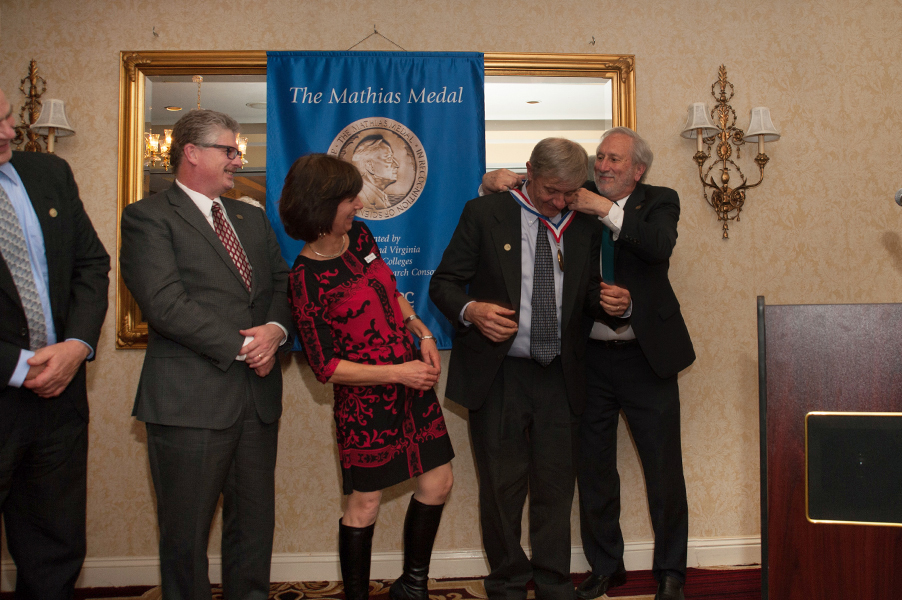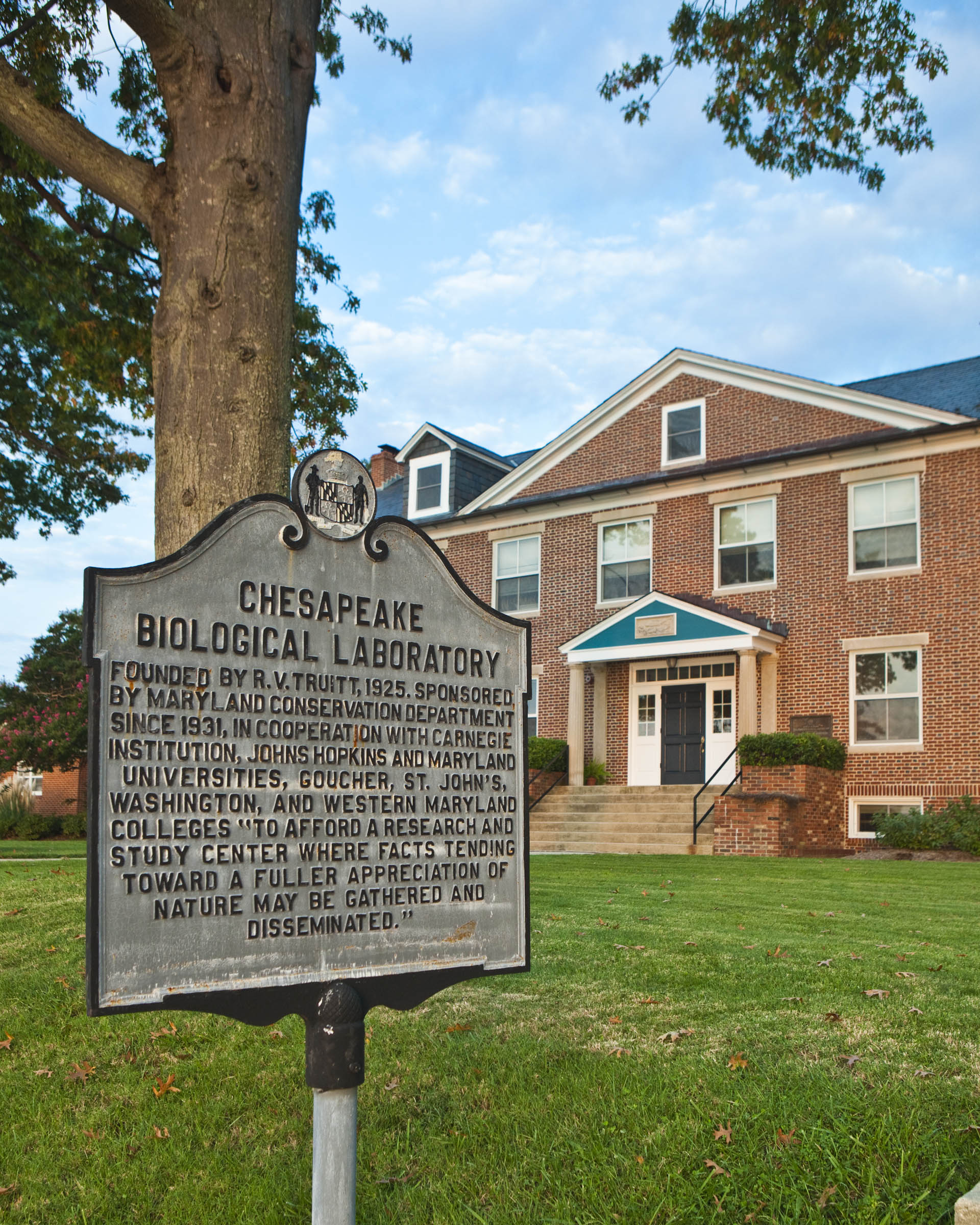Growing up in Massachusetts, Walter Boynton joined his father and brother for occasional trips to the coast just to watch the ocean.
The fond memories evolved over the years into a devotion and storied career in marine science. Now on the brink of his retirement, the University of Maryland Center for Environmental Science professor who has already earned the rank of “Admiral of the Chesapeake” is due to receive the Mathias Medal, a prestigious award presented to only six other scientists in nearly three decades.
It’s an honor he never saw coming.
“I have to admit, I almost fell off my chair,” Boynton said. “I don’t run my life thinking about awards. It came as an emotional shock. I felt pretty humbled.”

Founded in 1990, the Mathias Medal is awarded jointly by Maryland Sea Grant, Virginia Sea Grant, and the Chesapeake Research Consortium. The award is named for the late U.S. Sen. Charles “Mac” Mathias of Maryland, who championed efforts to clean up the Bay. It aims to recognize outstanding scientific research that contributes to informed environmental policy in the Chesapeake Bay region.
“Over the last 47 years, Walter has embodied what every good scientist should be—objective, passionate, and engaged,” said Tom Miller, director of the Chesapeake Biological Laboratory, where Boynton works. “These traits make him not only the one that his colleagues turn to for collaboration and advice, but also the one politicians and policy makers turn to when they want to understand the issues and get it right.”
UMCES President Don Boesch called Boynton an exemplar for the faculty.
“His dedication to leading-edge science and its effective communication and practical application for the benefit of society and world in which we live embodies everything this institution stands for,” Boesch said.
Honoring scientific pioneers
In earning the Mathias Medal, Boynton joins an elite group of scientific pioneers and is proud to be among greats he also knew, including L. Eugene Cronin, the second medal recipient. He won the award in 1994 for his work in understanding Chesapeake Bay biology. Cronin hired Boynton on at the Chesapeake Biological Laboratory in 1975. Boynton recalled fondly that Cronin always offered his full support on his work there.
While Boynton is the one to receive the award, he was quick to share credit for earning it.
“It’s not just for me. It’s much more of a ‘we’ than a ‘me.’ That’s been the theme of all the work I’ve done,” he said. “I don’t believe I’ve ever published a paper with just me as an author. I’ve always collaborated.”
Collaboration has been a key part of his work here, Boynton said, pointing to Michael Kemp—an UMCES professor who he met in graduate school—as his best partner. Kemp started at UMCES’ Chesapeake Biological Laboratory shortly after Boynton and now works at Horn Point Laboratory.
“Walter and I, we developed a synergistic relationship,” he said. “He’s really good at things I’m not so good at and vice versa.”
In 2009, the two men even collaboratively won an award—Coastal and Estuarine Research Federation’s Odum Award, which recognizes the lifetime achievements of outstanding estuarine scientists.
Simplifying science
That Boynton would earn the Mathias Medal was fitting of his personality and expertise, Kemp said.
“The focus of his research has always been about protecting the environment and understanding the need to protect it, manage it, and restore it. Those are all the things Mac Mathias felt strongly about,” Kemp said.

Boynton said part of his happiness in receiving the Mathias Medal stems from the idea that it celebrates stewardship. The content of a historic marker outside the Chesapeake Biological Laboratory serves as his reminder that a scientists is to "try to figure out how nature works and to tell people about that,” he said.
“I’ve always found that to be incredibly inspiring,” Boynton said. “I think that’s really what the Mathias Medal is about. When we figure out something about how nature works, we can tell people about it.”
The opportunity to achieve change depends heavily on how well scientists can communicate with the public, Boynton explained. They shouldn’t oversimplify their findings because they might leave out something important, he said, but they need to clarify it so a broader audience can understand the issue and respond to it.
Boynton pointed to eutrophication as an example. He realized he needed a better way to explain what was happening to the Bay than using the scientific term for it. He started saying “nutrient obesity” to explain the Bay was suffering from too much of a good thing, in this case, nutrients. That helped him explain the problem, which was dense growth of plant life that limited oxygen and posed a risk to marine life.
“If the management community and certainly the political community don’t have a gut-level feeling that they understand this, then I don’t blame them for not taking action,” Boynton said.
‘A treasure chest of possibilities’
Boynton has worked out of the Chesapeake Biological Laboratory for over 40 years. He first came to Solomons for a summer internship in 1969. He was finishing his undergraduate program at Springfield College, a small liberal arts college in western Massachusetts, when he learned of the opportunity from a flier on a bulletin board.
He arrived fresh off the Appalachian Trail. He and a fellow student opted to hike the trail in lieu of taking a sociology class to earn their final credits needed to graduate. In all, they covered 1,500 miles in 90 days, starting in Springer Mountain, Georgia and ending at the Massachusetts-Connecticut state line.
Somewhere along the way in Pennsylvania, Boynton recalled splurging on a long-distance call to phone home and let his family know they were alive and well. That was when his father told him a letter had arrived from Solomons in Maryland. He got the internship.
Boynton was at Chesapeake Biological Laboratory for a year and a half and left in 1971 to earn higher degrees. He went on to earn his master’s degree at University of North Carolina and his doctorate from the University of Florida.
Boynton was weighing offers from University of Texas and U.S. Environmental Protection Agency when he got a call about an open faculty position at Chesapeake Biological Laboratory. For him and his wife, Mary Ellen, who he started dating during his second summer at the Maryland lab, it was a sort of homecoming when they came back to Maryland in 1975.
There was plenty to draw them back to Maryland, Boynton said. It was closer to their families, colleagues had become personal friends, and they enjoyed living in the area. There was also the biggest estuary in the United States.
“In the little research work I had done in the Chesapeake, it struck me as a treasure chest of possibilities,” he said.
A list of accomplishments
The Bay and its tributaries, he explained, encompasses a variety of environments from tidal freshwater to near-ocean salinity, as well as tidal wetlands, seagrass communities, waters that are mostly shallow but occasionally deep, oyster communities, and great fish communities.
“Chesapeake Biological Laboratory sits right on the shores of the Bay. All these environments were incredibly accessible,” he said.
Boynton wanted to be a field ecologist, going out onto the water and gathering data. He took advantage of that access, including his work to design, implement, and launch in 1984 a comprehensive monitoring program. Through consistent data gathering at dozens of sites in the Bay and its tributaries, the program has helped show the Bay’s status over time and identify trends that could lead to action.
Boynton pointed to three projects as his most useful accomplishments during his career, in part because of the actions that followed this research.
One of his first projects was to study the rockfish issues. Having explored the location, timing, and factors influencing the fish’s recruitment in the Bay, the research helped identify issues causing a decline of the striped bass. His work helped motivate a fishing moratorium, which is a management practice that helps revive population.
Boynton was also pleased with his part in demonstrating that seagrasses were leaving the Bay due an excess of nutrients, and for revealing that nitrogen, not just phosphorous, was to blame for eutrophication of many estuarine ecosystems. The latter lead to the adoption of a dual-nutrient reduction strategy that aimed to prevent eutrophication and the increase of harmful algal blooms in the Bay.
More recently, Boynton and his colleagues are seeing positive changes as the Bay appears to turn a corner toward a healthier state. He sees that as strong evidence that ecosystems do respond to strong management actions.
“I think we have the science right in the big picture. This is the kind of news the public needs to hear: We’re starting to see restoration trends, but we are not done.”
Neither is Boynton.
He is set to retire June 30, 2017, but he calls it simply “going off the payroll.” He plans to apply for emeritus status to allow him more time to do some of the work he wants to do, but on a less rigorous schedule. That should leave him time, he hopes, to tend more carefully to his vegetable garden and volunteer in the community.
Story by Kristi Moore

